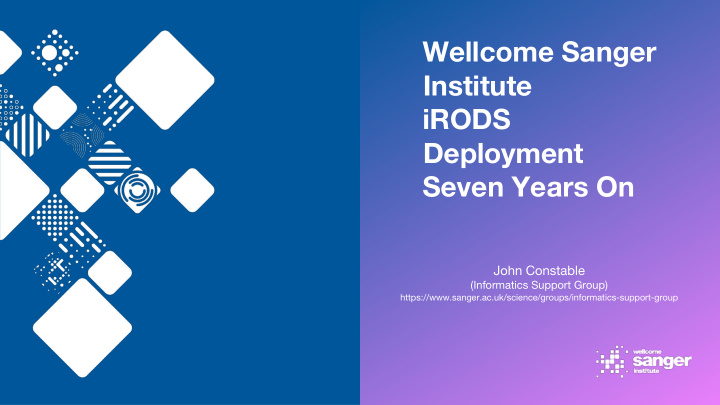



Wellcome Sanger Institute iRODS Deployment Seven Years On John Constable (Informatics Support Group) https://www.sanger.ac.uk/science/groups/informatics-support-group
It’s been seven years since "Implementing a genomic data management system using iRODS in the Wellcome Trust Sanger Institute.” (https://www.ncbi.nlm.nih.gov/pubme d/21906284) was published.
Gosh
Recap
“Increasingly large amounts of DNA sequencing data are being generated within the Wellcome Trust Sanger Institute (WTSI). The traditional file system struggles to handle these increasing amounts of sequence data. A good data management system therefore needs to be implemented and integrated into the current WTSI infrastructure. Such a system enables good management of the IT infrastructure of the sequencing pipeline and allows biologists to track their data” Image Credit: Pablo Gonzalez (Flikr)
First failed. Second failed. Third one stayed up!
So we installed iRODS 1.0 (the paper was written on 2.4.0)
It had seven servers! Two Zones! Two iCAT’s, federated. Four iRES, replicated. It authenticated against Active Directory. We used Oracle as the Catalog Backend database, as was the fashion at the time.
We started by adding Storage via SAN. First Nexsan, then DDN. ~400TB per server It got used a lot so we added more zones. More capacity each year. Photo Credit: nolnet (Flikr)
We (Pete) upgraded to 3.3.1 Photo Credit: Brian Rinker (Flikr)
We moved half of the storage to another data centre. While the system was live. With no one noticing. On a lorry. (You may have seen my colleague Jon Nicholson’s talk on this) Photo Credit: Brickset (Flikr)
We upgraded to 4.1.8 (You may have seen my previous talk about this) Took a year of prep. Further upgrades took an hour, including prep. Currently on 4.1.10, 4.1.11 on dev. Hoping to jump to 4.1.12 soon Photo Credit: brickdisplaycase.com (Flikr)
We ran into scaling issues; One server could get its 10G ● overloaded. The number of multipath paths ● got to over 2k on each server! Could not readily make LUN’s ● > 60TB due to fsck memory limits One server maintenance took a ● lot of storage offline Photo Credit: Rob Young (Flikr)
We switched to using 4U servers incorporating 10G networking and 60 disks. Initially Ubuntu 12.04 Recently Red Hat 7 Photo Credit: Fred Dunn (Flikr)
This scaled very nicely.
One part time of one FTE to manage. Today one full time FTE, plus others at times of high load Photo Credit: Judy van der Velden (Flikr)
One Zone exports its resources via read-only NFS. Allows researchers to compute across ‘all their data’, maintains the same workflow with migrating between file tracking platforms.
Almost all data is from automated pipelines, very few users upload their own data. Getting the automated pipelines has been the key to ubiquity, for us.
Wrote our own tools and automation: CFEngine and Ansible Baton Assorted Python maintenance scripts Vagrant environment for testing (you have have seen my previous talk on this) Scripts to recover a Resource from other replicas Unit tests (not enough) Photo Credit: noriart (Flikr)
Monitoring; Ganglia ● Collectd & Graphite for specific ● dashboards Quota dashboards & PDF ● monthly reports Capacity (this is by far the hardest) ● Access Usage (this has been by far ● the most valuable) Logging; Splunk and ● ElasticSearch Nagios ● Photo Credit: Okay Yaramanoglu (Flikr)
Current Infrastructure: 129 servers ~18PB (~9PB, replicated) Includes Dev zone that mirrors ● production (smaller resources) Six Zones (one not federated) ● One Zone HA (You may wish to see ● my upcoming talk about this) Photo Credit: Paul Hartzog (Flikr)
Lessons learned Monitoring, logging and ● instrumentation (aka ‘observability’) still very early days Could really do with an ● Infrastructure As Code approach to spinning up dev environments on our Openstack Cloud When problems found ● resolution in months. We are not bleeding edge but scale brings its own challenges. So even community battle tested releases have edges unknown. Photo Credit: Benjamin Lim (Flikr)
With Thanks to: Dr Peter Clapham Dr James Smith (lego collector extraordinaire) The lego community that make their work available via Creative Commons
Thank you for listening! john.constable@sanger.ac.uk @kript
Recommend
More recommend